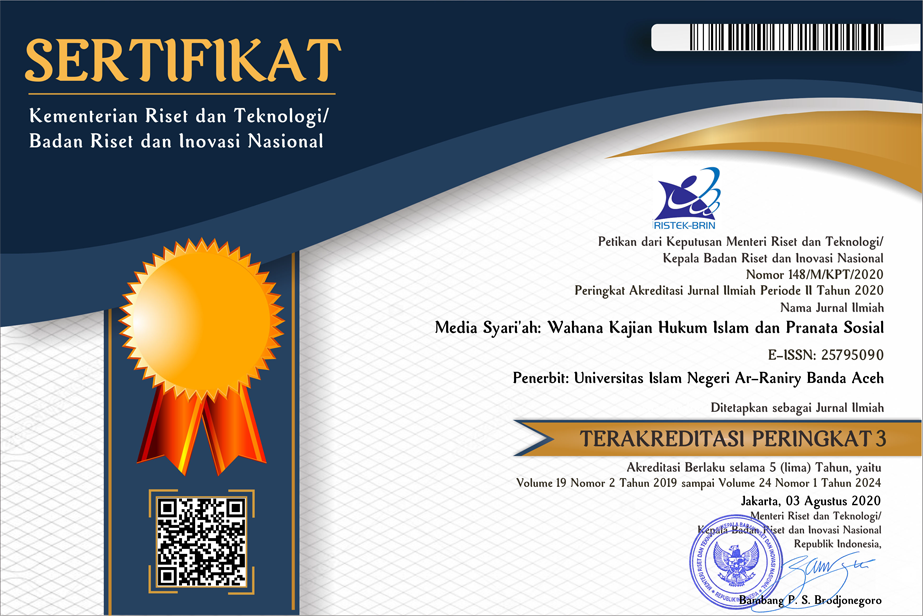Poverty Measurement In Malaysian Zakat Institutions: A Comparison Between Monetary And Non-Moneary Measurement
DOI:
https://doi.org/10.22373/jms.v18i1.1838Keywords:
Poverty, measurements, multidimensional, monetary indicatorsAbstract
There are various definitions of poverty in the teachings of Islam. In principle the poor are defined as those whose needs are insufficient. Thus, Islamic institutions in Malaysia play a variety of socioeconomic roles such as poverty alleviation. To perform this role, these institutions face a major task in identifying the poverty group. Most of these institutions measure and operationalize poverty from the monetary perspective using variables such as income, expenditure or consumption. In practice, most Islamic institutions in Malaysia use the monetary approach in measuring poverty through the conventional Poverty Line Income (PLI) method and also the Islamic based Had Al-Kifayah (HAK) method. The objective of the paper is to present a non-monetary shariah based poverty measurement, Islamic Poverty Index (IPI), consisting of maqasid-al sharia (objective of the religion) elements, namely religion, knowledge, physical-self, offspring and wealth. The IPI, calculated using the weighted index method is expected to exemplify poverty from a multidimensional perspective. In addition, a comparison with the HAK method was highlighted. A survey aided by a structured questionnaire using expert review was carried out on 258 selected head of households in the state of Selangor, the most populated state in Malaysia. Poverty groups identified from each of the methods were highlighted using descriptive statistics. In addition, regression analysis revealed that unemployment was the common significant determinant of poverty according to both the IPI and HAK method.References
Alkire, S. & Santos, E. M. (2010). Acute Multidimensional Poverty: A New Index for Developing Countries. OPHI Working Paper No. 38. Oxford University Press.
Awan, M.S., Waqas, M. & Aslam, M.A. (2011). Multidimensional Poverty in Pakistan: Case of Punjab. Journal of Economics and Behavioral Studies, Vol. 2, No. 8.
Awan, M.S., Waqas, M. & Aslam, M.A. (2012). Multidimensional Measurement of Poverty in Pakistan. MPRA Paper No. 41532.
Imran Sharif & Shahwanaz Malik (2005). Evolving views on poverty and welfare: An analysis of conventional and Islamic approach. The Journal of Research, No. 7.
JAWHAR.(2007). Manual Pengurusan Zakat. Jabatan Perdana Menteri Malaysia.
Junaidah Abu Seman and Nazam Dzolkarnaini (2014). Construction od Maqasid Al- Shariah Based Index of Socio-Economic Development: Concepts and Issues. Paper presented at Seminar on Maqasid Al-Shariah Based Socio-eonomic Index. April 30- May 1. Islamic Research and Training Institute (IRTI), Islamic Dev. Bank (IDB), Jeddah.
Kamali, Mohd Hashim (2009). Maqasid Made Simple. The International Institute of Islamic Institute (IIIT).
Laderchi, C. R. (2000). The monetary approach to poverty: a survey of concept and methods. QEH Paper Series 58
Laderchi, C,R, Ruhi Saith and Steward, F. (2003). Does it matter that we don’t agree on the definition of poverty. QEH Paper Series 17.
Mohamed Saladin Abdul Rasool, Mohd Fauzi Mohd Harun, Arifin Md Salleh & Noraini Idris. (2011a). Poverty Measurement in Malaysia: A Survey of the Literature in AKADEMIKA, Journal of Southeast Asia Social Science and Humanities, Jilid 81 Bilangan 1 (Jan-April). Penerbit Universiti Kebangsaan Malaysia (UKM).
Mohamed Saladin Abdul Rasool, Mohd Fauzi Mohd Harun, Arifin Md Salleh & Noraini Idris. (2011b). Poverty Measurement in Malaysian Zakat Institutions: A Theoritical Survey in Jurnal Ekonomi Malaysia, Vol. 44 (December). Penerbit Universiti Kebangsaan Malaysia (UKM).
Mohamed Saladin Abdul Rasool, Arifin Md Salleh & Mohd Fauzi Mohd Harun. (2012). Poverty Measurement by Islamic Institutions. International Journal of Social Management, Economics and Business Engineering, Vol. 6 No. 5.
Mohamed Saladin Abdul Rasool & Ariffin Md Salleh (2014). Non-Monetary Poverty Measurement in Malaysia: A Maqasid Al-Shariah Approach. Islamic Economic Studies, Vol. 22 No. 2, Nov.
Nolan, B. and Whelan, C.T. (2010). Using non-monetary deprivation indicators to analyse poverty and social exclusions. Lesson from Europe? Journal of Policy Analysis and Management Spring, Vol. 29.2.
Nolan, B. and Whelan, C.T. (2012). Using non-monetary deprivation indicators to Analyze European Poverty and Social Exclusion in Counting the poor: New Thinking about European Poverty Measures and Lessons for United States. Besharov, J.D.and Couch, A.K. (ed.). Oxford University Press.
Nussbaum, M. (1997). Capabilities and Human Rights. Fordham Law Review.
Nussbaum, M. (2003) Capabilities as Fundamental Entitlements. Sen and Social Justice. Feminist Economics. 9 (2-3).
Peerzade, Syed Afdzal (1997). The definition and measurement of poverty: An integrated Islamic approach. The Pakistan Development Review. Islamabad.
Rafi Amiruddin (2014). Maqasid Al-Shariah. Are We Measuring the Immeasurable? Islamic Economic Studies, Vol. 22 No. 2. Nov.
Ravallion, M. (1998). Poverty lines in theory and practice. LMS Working Paper, 133.The World Bank.
Rahmatina Kasri and Habib Ahmed (2014). Assessing Socio-economics Development Based on MaqasidAl-shariah Principles. Normative Framework, Methods and Implementation in Indonesia. Paper presented at Seminar on Maqasid Al-Shariah Based Socio-eonomic Index. April 30- May 1. Islamic Research and Training Institute (IRTI), Islamic Dev. Bank (IDB), Jeddah.
Ravallion, M. (2012). Poor or Just Feeling Poor.On Using Subjective Data in Measuring poor. Policy Research Working Paper 5968. The World Bank.
Rodriguez J. G., Martinez, M.G., Santoyo, L.S., Lozano,M,Q and Weber, G.Y. (2010). Chronic and Transient Poverty in Mexico. Economics Buletin, Vol 30, No.4.
Rosbi A. Rahman and Sanep Ahmad. (2010). Pengukuran keberkesanan Agiham Zakat: Perspektif maqasid al-syariah. Proceedings of Seventh International Conference The Tawhidi Epistemologi: Zakat and Waqf fund. 6th -7th January. Institut Islam Hadhari, UKM Bangi, Malaysia.
Rupasingha, A. and S.J. Goetz (2007). Social and political forces as determinants of poverty:A spatial analysis. The Journal of Socio-Economics. 36 (2007) 650–671.
Sen, A.K. (1977). Development as Freedom (DAF). Oxford. Oxford University Press.
Sen, A.K. (1987). The standard of living: lecture ii, lives and capabilities in G. Hawthorn (ed.) The Standard of Living, The Tanner Lectures (clare Hall), Cambridge.
Sen, A. K. (1992). Inequality Reaxamined. Harvard University Press, Cambridge, MA.
Shirazi, Nasim Shah. (1996). Targeting, Coverage and Contribution of Zakat to Households’ Income: A Case of Pakistan. Journal of Economic Cooperation among Muslim Countries. 17 3-4 (1996).
Shirazi, N.S. (2006). Providing for the resource shortfall for poverty elimination through the instrument of zakat in low income muslim countries. IIUM Journal of Economic and Management 14 no 1 (2006).
Downloads
Published
Issue
Section
License
MEDIA SYARI'AH: Wahana Kajian Hukum Islam dan Pranata Sosial has CC-BY-SA or an equivalent license as the optimal license for the publication, distribution, use, and reuse of scholarly work. Authors who publish with this journal agree to the following terms:
1. Authors retain copyright and grant the journal right of first publication with the work simultaneously licensed under a Creative Commons Attribution-ShareAlike 4.0 International License that allows others to share the work with an acknowledgment of the work's authorship and initial publication in this journal.
2. Authors are able to enter into separate, additional contractual arrangements for the non-exclusive distribution of the journal's published version of the work (e.g., post it to an institutional repository or publish it in a book), with an acknowledgment of its initial publication in this journal.
3. Authors are permitted and encouraged to post their work online (e.g., in institutional repositories or on their website) prior to and during the submission process, as it can lead to productive exchanges, as well as earlier and greater citation of published work (See The Effect of Open Access).
You are free to:
Share — copy and redistribute the material in any medium or format.
Adapt — remix, transform, and build upon the material for any purpose, even commercially.
The licensor cannot revoke these freedoms as long as you follow the license terms.
All papers published in MEDIA SYARI'AH: Wahana Kajian Hukum Islam dan Pranata Sosial are licensed under a Creative Commons Attribution-ShareAlike 4.0 International License.



.png)


.png)
.png)
.png)



